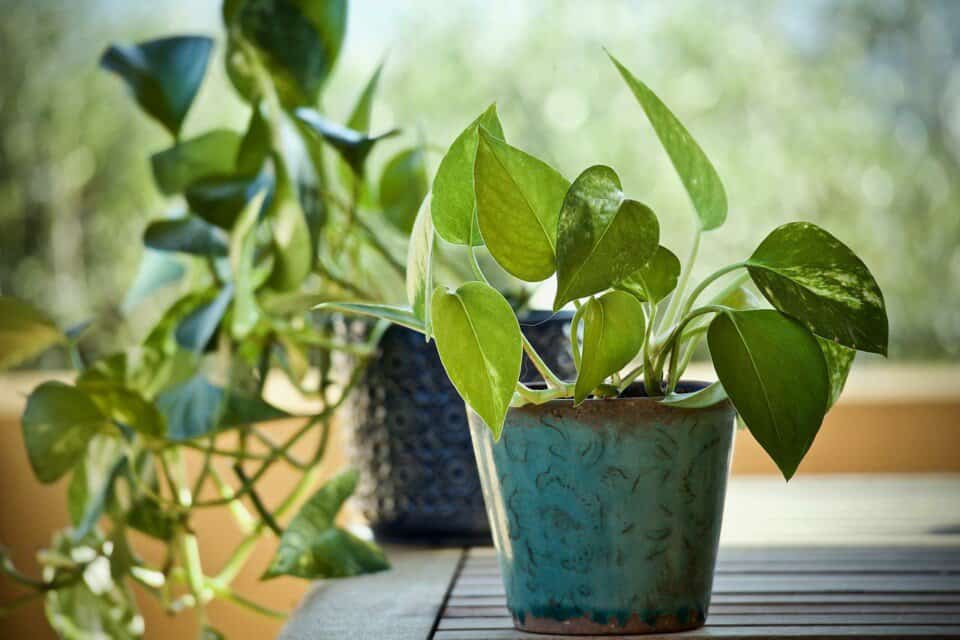Some links in the post are affiliate links and I get a commission from purchases made through some links found in the post.
Many beginners start by growing the pothos; I was always curious why that was. That is until I saw someone root a pothos in water, and the plant was thriving after months.
Now, she has this trailing vine scaling her walls and imparting natural beauty to her space. So, naturally, I was attracted to the plant and wanted to know how I could root one and what mistakes I should avoid.
The first advice I got from most gardeners was to avoid propagating a pothos from seed. While that would not have been my first choice, I eventually looked up why this was a big no-no in the gardening community.
It turns out that only fully mature pothos can flower and produce seeds. And this only takes place in the wild, with the last flowering incident dating back to the 20th century. Yikes!
The best way to propagate a pothos lies in rooting cuttings. Find the tip of the cutting and count three leaves below it.
Then, using your cutting tool, cut at a 45-degree angle an inch below the lowest leaf. Then you can root the cutting in soil or water.
Before I get into the propagation process, I will answer some frequently asked questions about propagating a pothos.
Let’s get into how you can get started on this exciting (and surprisingly easy) journey:
Why Propagate a Pothos?
There are so many reasons why growing a pothos is a good idea, namely:
- They are low-maintenance plants,
- They are known to purify the air,
- They are beautiful,
- They are versatile,
- They raise the humidity in the home, and
- They have a soothing effect.
So, adding one to your space might just be the good luck charm you need to brighten your home!
Where On a Pothos Should You Propagate?
 You can propagate a pothos by using a cutting. So, before I get into this topic any further, what is a cutting?
You can propagate a pothos by using a cutting. So, before I get into this topic any further, what is a cutting?
It is a piece of the stem or root of an existing mature plant that you can use to grow a new plant. Because the new plant resembles the parent plant, rooting cuttings is much like cloning the existing plant.
But not all cuttings you get from a pothos will result in another pothos plant. Instead, you must pay particular attention to the nodes.
These are the sections of the plant where the leaves intersect with the stems, i.e., where new leaves form. And when used for rooting, these are the sections where the new roots of the new pothos plant emerge.
We focus on the nodes because they have high cellular growth action because of the high level of meristematic tissue cells.
And if you submerge these in a rooting medium, they will give rise to new plant parts because the cells will receive the signal to develop roots.
That is why pothos plants can grow fast in the wild devoid of the need to flower and seed. The vines can keep producing new roots and establishing further in the soil, all while relying on this rooting action.
Nodes appear as nubs on the mature pothos plant with greyish-brown hues.
In the propagation section, I will walk you through how you can identify them so you can ensure your cuttings have what it takes to develop into healthy plants.
Can You Propagate Pothos from Just a Leaf?
Unfortunately, you cannot propagate a pothos plant from a leaf. That is because leaves do not have the same high cellular growth action present in the nodes.
As such, even if you submerge the leaf into water or any other rooting medium, no signal will trigger the cut part to develop roots. That is not how pothos grow. Instead, you must use a cutting that has at least one node.
Can You Propagate Just the Stem of a Pothos?
Leaves are essential in the making of food which gives the cutting energy to grow. So, having some leaves on your cutting favors its chances of growing. But does this mean that cuttings without leaves will not grow?
Not at all! You might think that your cutting needs to have leaves for it to grow into a healthy plant. But this is hardly the case.
Your pothos cutting only needs to be in the right rooting medium and have at least one node. The high cellular action will then enable the plant to root; once this occurs, the new leaves will eventually follow.
These will then produce the food needed to help the pothos grow bigger and faster. As long as your cutting has at least one node, you can use it.
Can Pothos Be Propagated Without a Node?
The cellular action required to trigger the development of roots in your pothos cutting is present in the nodes.
Thus, even if you pick a healthy stem with leaves but without a node, the cutting will not root. Ensure that the cutting you choose has at least one node, and it will root.
What Are the Stages of Propagation of a Pothos?
You can propagate a pothos through rooting cuttings. I will walk you through the method in detail so you can understand how to go about it:
Rooting Cuttings
 This method is similar to what you may have already achieved with other trailing plants in your home. What you need is to find a healthy parent plant from which you can source the cuttings.
This method is similar to what you may have already achieved with other trailing plants in your home. What you need is to find a healthy parent plant from which you can source the cuttings.
Please note that the emphasis here is on the health of the plant. After all, if a plant has a weakened immune system, it might not survive the pruning. You could also pass some of these inadequacies to the young plant, which would hamper its growth.
Step 1: Choose a Rooting Medium
Before I cover what you need to root cuttings (besides a healthy parent plant), I will cover what to consider when choosing a rooting medium.
The standard options are water and soil. Most people prefer doing it in water (me included), but soil also has some advantages you may want to consider. Let’s weigh the options:
a. Rooting in Water
Why should you root your pothos cuttings in water?
- Speed: Water is the best option if you want your cuttings to root in a matter of weeks. Generally, rooting takes place in about three to five weeks. You will see the results much faster if the rooting is in adequate light and if you have sped up the process with a rooting hormone.
- Ease: Most beginners start by rooting their pothos cuttings in water because they do not need to worry about if the drainage is sufficient and other factors. With water, you just plop the cutting into the medium and go about your activities. That is much less intensive than potting soil, where you need to get a good soil mix, adjust the water retention, and measure the amount of water you feed the cutting.
- Safety: With soil, there is the risk that the potting soil might be too wet for the pothos cutting. And unfortunately, that increases the likelihood of root rot which can damage the cutting and force you to start from square one. As such, you need to be more hands-on with the care routine. But with water, you do not face this risk.
- Beauty: You can see the roots as they develop in the water. And this helps you keep tabs on the progress of the rooting. Besides that, you also get a natural display of beauty because submerged rooting plants make for quite the centerpiece.
Are there disadvantages to rooting your pothos in water? Sure! Such cuttings require you to keep changing their water as they use up the oxygen in the water.
Also, because you grow them in water, they suffer quite a shock when you move them to a potting mix. And that can slow their growth for a considerable while.
b. Rooting in Soil
Soil mediums make up for the shortcomings of rooting pothos cuttings in water. How so?
- Reduced transplant shock risk: Your pothos will have already acclimated to being in soil and will thus not react harshly to being transplanted once the time comes. That is unlike pothos rooted in water, as these tend to be more sensitive to environmental changes.
- No need to change water: With soil mediums, you will not need to keep changing the water. That is because the cutting relies on the oxygen in the soil medium, which it does not deplete.
On the downside, rooting in soil takes a much longer time. Usually, you need to wait about two to three months before you can see the results of your hard work.
And because you cannot view the roots, you will likely need to put up with a lot of guesswork.
Also, soil mediums run the risk of high water retention, which can subsequently lead to root rot.
I would thus recommend this option to experienced gardeners who can manage moisture levels without drowning or dehydrating the pothos cuttings.
Again, this is a matter of what works best for you as the gardener.
Step 2: Gather Your Materials
Other than a healthy pothos plant, you will need to collect:
- A pair of cutting tools – You can use anything from scissors to the knife that is right in your kitchen. However, ensure the tool is sharp so it can cut in one go. Else, you will bruise the parent plant, and the cutting you source will face a high likelihood of infestation. That is the last thing you want when you propagate a young pothos plant.
- A disinfectant – Not only must your tool be sharp, but it should also be clean. Using soap on the tool is insufficient because most soaps are not strong enough to eliminate disease-causing microorganisms. I prefer using alcohol, but bleach works just as well.
- A jar – It is best to use a glass jar for environmental reasons and to prevent chemicals from leaking into the young pothos. But this could as well be a matter of preference. You can use what’s available instead of searching far and wide for that perfect glass jar.
- A small pot – If you will root the pothos in soil (I will describe the rooting mediums later), you will need a small pot. Fill it with a peat-based mixture that is well-draining. The pothos is not too particular about soil as long as it does not retain too much water.
You can also add a rooting hormone to the list. The essence of the hormone is to encourage rooting so that the pothos has a higher chance of growing.
But this, just like many other materials you will come across, is optional. And if you don’t have it, don’t fret – your pothos can still grow if you source the cutting from a healthy plant and provide it with ideal conditions.
Step 3: Choose the Right Time
 Your pothos cuttings will do best when the weather is ideal. And based on USDA ratings, this plant prefers hardiness zones 10 to 12, which are pretty warm.
Your pothos cuttings will do best when the weather is ideal. And based on USDA ratings, this plant prefers hardiness zones 10 to 12, which are pretty warm.
In these conditions, the parent plant (which is essential to the growth of the cuttings) will be at its peak and give rise to healthy stems and leaves.
Picking such cuttings increases your success rate and reduces the bruising on the plant.
Thus, if you live in a region with harsh winters, save the propagation for the spring and summer when the temperatures are more bearable.
The temperature should range between 65- and 85 degrees Fahrenheit with a humidity of at least 50%.
If you live in a warm area, you can propagate the pothos at any time, provided the prevalent conditions match the recommendations above.
Step 4: Disinfect Your Tools
Now is when you will use the bleach or alcohol I indicated earlier. What is the essence of this? Well, just like human beings, plants run the risk of getting infested by disease-causing pathogens.
And these can be anywhere, from the parent plant to the cutting tools, down to the surfaces near the plant. So, you must treat the propagation like surgery and avoid introducing these pathogens into the parent plant or its cutting.
And the way to do this is to make a clean and sterile cut when picking the cutting. When the cut is clear, it is much easier for the cutting to absorb water and nutrients and thus trigger root growth.
Sterilizing your tools is easy. You will need a clean cloth which you can soak with bleach or alcohol. Rub this wet cloth over your tool of choice and allow the liquid to dry before proceeding.
Step 5: Choose a Parent Plant
Please note that using cuttings is much like cloning the existing plant. As such, the young pothos will look like the parent plant. So, you should get a cutting from a variety you like because the physical structure will be similar.
Besides the plant’s appearance, look into whether the parent plant is a suitable source for cuttings. Look into the following factors:
- Does the plant show signs of pest or disease infestation? A pothos that suffers from yellowing, browning, drooping, and other conditions is unhealthy. Instead of using it as a source of cuttings, investigate the cause of these adverse changes and deal with them accordingly. A cutting sourced from such a plant stands a poor chance of growth and may take a considerable while to root.
- Does the plant show strong growth? Vines are a great show of the state of the plant. A healthy pothos should have a strong stem with healthy leaves emanating from the vine. But if the vine appears brown, mushy, or has few or small leaves, that points to an issue with its health. A leggy pothos is not the most ideal candidate. However, you cannot pass on leggy growth because it often results from external factors. Thus, you can prune the pothos to deal with the leggy growth and use the resultant cuttings to grow new plants.
Generally, your choice of parent plant should exhibit strong and healthy growth. These are the features you want to pass down to the plant that results from the cutting.
Step 6: Make the Cuttings
Now is the time to locate the nodes and make cuttings at least four inches long. You do not need to get a cutting longer than 6 inches. Nodes appear as brownish nubs along the vine from which leaves emanate.
They appear like elbows on the plant, and spotting them is relatively easy. A cutting with at least one node should be good enough for propagation.
But to avoid missing out on a healthy plant or waiting too long for the rooting, choose healthy cuttings with at least three nodes. The chances will even be better if the cutting has leaves on it – at least three should be enough.
Find the tip of the cutting and count three leaves below it. Then, using your cutting tool, cut at a 45-degree angle an inch below the lowest leaf.
This distance between the bottom of the cutting and the lowest leaf ensures that the leaf does not end up in the soil or water. And as such, it does not decay and instead makes food for the plant to aid in the root growth.
So, how many cuttings do you need? There is no maximum number of cuttings as it increases your chances of success and also depends on how many pothos plants you want to grow.
However, I discourage pruning the parent plant too much as this can send it into shock. Cut the plant back by no more than a third of its size and allow it to recover from the pruning.
Step 7: Root the Cuttings
Based on the rooting medium you chose, you will need to root the pothos cutting in water or soil. If you would like to try both, that is also an option, especially if you want to grow several pothos plants at once.
I will show you how to use both methods below so you can select what augurs best with your gardening needs:
a. Root the Cuttings in Water
 Propagating pothos cuttings in water is a common method because it is easy. All you do is:
Propagating pothos cuttings in water is a common method because it is easy. All you do is:
- Place the cutting in water in a jar with at least 4 inches of space allowance. The space should be enough to accommodate the height of the cutting so that it remains in the water. You should also get one with a rim that allows the leaves to remain out of the water. Else, the leaves will start decaying owing to the moisture exposure. Most jars can serve this purpose.
- Fill the container with purified water up to three-quarters of its depth. That way, the leaves will remain out of the water, and you will not run the risk of leaf damage. At least one node should be in the water because this is where the rooting will start. Also, avoid using tap water as it contains chlorine which can hamper the growth of the cuttings. You can still use tap water if you cannot get your hands on purified water. But allow it to sit in the jar for about two hours before placing the pothos cutting in it.
- Judge the cutting placement based on the pothos plant you want to grow. If you are after several vines with thick foliage, you can lay the cutting horizontally so that more nodes can touch the water. But if you want a strong single vine, lay the cutting vertically so that only the lower node touches the water.
The cutting should root in the next three to five weeks, allowing you to transplant it to a favorable location. In the meantime, you should remember to change the water every week. Else, the cutting will lack oxygen and die.
b. Root the Cuttings in Soil
What if water is not your cup of tea? While many people favor the use of water, some still prefer using soil. If you are also drawn to earth, you can root your cutting as follows:
- Find a small pot that is at least 4 inches deep to accommodate the size of your cutting,
- Fill the pot with well-draining potting soil to half of its level. Nutrients are not the focus at this point, so you should cater more to the drainage aspects of the potting mix to ensure that your cutting does not suffer root rot. Peat-based mixtures work great. Remember that an underwatered cutting has a higher chance of survival than an overwatered one – the latter can suffer root rot and die.
- Place the cutting in the soil and fill up the rest of the pot with the potting soil. Leave an inch between the top of the potting mix and the tip of the pot. Also, ensure that the lower leaf is above the soil surface and does not touch the soil.
- Wet the soil until the excess water drains from the drainage holes (your pot should have enough of these).
That’s it. You must keep watering the soil when it feels dry two inches below the surface.
You can use a moisture gauge to help you know when to feed the soil with water and when to let it be. But if you are good at gauging by touch alone, you can forego the meter.
Is rooting hormone necessary? The role of this hormone is to trigger more cellular action in the nodes and thus enhance the rooting process.
In most cases, this is not necessary. But when rooting your cutting in soil, this hormone can serve another role – keeping root rot at bay.
If you have had root rot issues or feel that you need some help with protecting your cutting, you can use this hormone. All you do is dip the end of the cutting in the hormone before placing it in the soil.
Please note that while it can help prevent root rot, it is not an absolute prevention measure. You must still follow through with a proper care routine.
Step 8: Provide Favorable Growing Conditions
Do you know what it takes for a pothos plant to be healthy? These are the same conditions you need to provide to the cutting for it to root fast and healthily.
Thus, you will also need to pay attention to the lighting besides warm temperatures, moderate humidity, and well-draining soil (or purified water).
Pothos can do well in full sun (bright and direct light) or partial shade (bright and indirect light with regard to the morning sun).
Most species prefer the latter as they use the photons from the light to make food which gives the plant the energy it needs to grow.
This light, also known as filtered or dappled light, mimics what pothos plants enjoy in the wild.
If you offer the plants too much direct light, especially in hotter regions, their leaves can suffer sunburn, which can halt photosynthesis.
But low light is not the option as this slows photosynthesis, resulting in slower rooting and slower plant growth.
Thus, your best bet lies in maintaining a balance between too much sun and too little light. You can place your cutting by:
- An east-facing window: This spot receives morning sun, which is not as harsh on the cutting as the afternoon sun. This option works best for people living in hot regions or in the summer when the temperatures can get out of hand.
- A south-facing window: This spot receives bright and direct sun. Thus, locate your cutting a few feet away from the window to avoid overwhelming it. Please note that this positioning works best for people in the northern hemisphere. If you live in the southern hemisphere, you should use a north-facing window.
West-facing windows can also work if you live in an area with a cool climate. But if you notice any burning on the plant leaves, you can move the cutting to a much more sheltered position.
Step 9: Transplant the Cutting
 Cuttings will be strong enough to grow on their own into mature plants once their roots are at least two inches long. You will have two options:
Cuttings will be strong enough to grow on their own into mature plants once their roots are at least two inches long. You will have two options:
- You can leave the cutting in water: If you are okay with changing the water every week, you can allow the pothos cutting to develop into a mature plant in the water medium. However, this will also limit how much it can grow.
- You can move the cutting to soil: If you want to move your cuttings from water to soil, be sure to do so once their roots are two or so inches long. Otherwise, they will have a hard time acclimating to the soil and may suffer poor growth because of their fine roots. Transplanting into soil is easy. Find a pot big enough to accommodate the vine and fill it with a peat-based nutrient-rich soil mix.
Then keep providing the plants with warm temperatures, moderate humidity, bright and indirect light, and enough water.
They will grow into healthy mature pothos from which you can get more cuttings. Now, let’s look at some more frequently answered questions.
How Long Does It Take for Pothos to Root in Water?
Rooting in water takes about three to five weeks. The time taken depends on how ideal the growing conditions are, the health of the parent plant, and if you use a rooting hormone.
What Propagation Method Are You Going to Use?
The choice of the method comes down to preference. However, using water is a good option if you want a faster turnaround without the risk of root rot.
And if you want to steer clear of transplant shock, soil makes more sense.
Is It Better to Propagate Pothos in Soil or Water?
Both options have upsides and downsides. Soil requires more maintenance and is best suited for experienced gardeners who can gauge how much water the cuttings need.
While water is the easier medium to figure out as all you need to do is change the water weekly.
Will The Propagated Area Grow Back?
Yes. Once you source a cutting from a pothos, the remaining stem will give rise to new shoots.
However, this only takes place when you do not bruise or infest the stem when taking the cutting. It is thus vital to exercise caution.
Final Thoughts
 Getting a mature pothos from the gardening store comes at a hefty price.
Getting a mature pothos from the gardening store comes at a hefty price.
But luckily, you can save money by rooting cuttings or separating the roots of already mature plants.
The propagation process is relatively easy to manoeuvre, and once you have it down to an art, you will soon be teaching other people how they can also grow a pothos. Happy Gardening!


